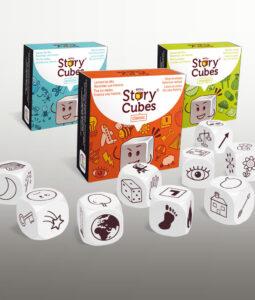
For my Competitive Analysis, I’d like to discuss the game ‘Rory’s Story Cubes,’ published by Zygomatic Studios in 2016. Several sets of Story Cubes can be purchased, each with different theming, such as ‘Voyages,’ ‘Primal,’ ‘Astro,’ and many more.
My group’s game for P1 is centered around the idea of building a story one-word-at-a-time, guided by a set of secret words that only each individual team knows. Story Cubes is similar to our game in that players build narratives using a chance-based system that generates story cues, which prompts players to think creatively about how to connect each cue into a cohesive narrative the whole group with find interesting and amusing. Building a narrative also prompts players to be collaborative, rather than adversarial, since disrupting/interrupting the storytelling isn’t received as well by the group as listening and following the existing structure. This dynamic contributes to both fellowship between players, in admiration for each other’s storytelling skills and ability to work together to create something new, as well as a narrative aesthetic from exploring creative storylines and unexpected plot-twists.
The feature of this game that makes it particularly notable and stand out from similar games is the complete lack of competitive mechanics. Story Cubes only expects players to craft narratives and entertain a group for the pure fun of it, rather than injecting extrinsic motivators such as a rigid point-system and having a zero-sum outcome. This mechanic relieves tension between players and contributes to a less stressful atmosphere, allowing players to take more risks in their stories and focus on group enjoyment rather than personal gain. This also resolves the problem of abuse in the game, since there is no obvious incentive for adversarial play.

The theming of the separate editions of the game all evoke different fantasy settings, ranging in time period and location, but similar in its sense of adventure and intrigue. As you can see above, the design of each icon on each dice is recognizable yet minimal, which lets players interpret them in a variety of ways and impress their own associations. This contributes further to creativity, and the fantasy aesthetic, building elaborate and memorable worlds.
Thinking of the Big Five (or maybe four, without neuroticism) Factors in O.C.E.A.N., I’d characterize Story Cubes as a game for someone who’s:
- Open (willing to accept random story cues)
- Non-Conscientious (easy-going, not too concerned with details)
- Extraverted (can think quick on their feet, take risks, entertain a group)
- Agreeable (willing to accept others’ ideas, can improvise)
While I think this game does a great job of maximizing creativity, minimizing stress, and allowing for wildly different styles of play between different groups, I think the complete lack of competitive structure may reduce its replayability. The game is not explicitly marketed for children, so I believe that a group of adults playing the game for the first time may appreciate how it provides good scaffolding for engaging storytelling, but beyond this feature, I think some mechanic should emerge that motivates players to stay creative for longer and take stories in more wild and entertaining directions. Something as simple as voting on a favorite story at the end of a round could provide good motivation for players.



